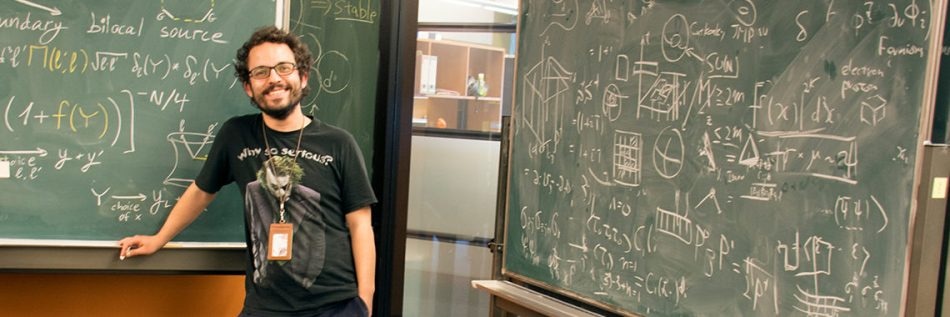Apr 2 2018
The research path of modern-day theoretical physicists is very hard.
 Yasha Neiman grapples with complex conundrums in quantum gravity on a daily basis. (Image credit: OIST)
Yasha Neiman grapples with complex conundrums in quantum gravity on a daily basis. (Image credit: OIST)
“As we learn more, reality becomes ever more subtle; the absolute becomes relative, the fixed becomes dynamical, the definite is laden with uncertainty,” stated physicist Yasha Neiman.
Neiman is a professor and head of the Quantum Gravity Unit at the Okinawa Institute of Science and Technology Graduate University (OIST) and confronts this difficulty almost every day. The goal of the field of quantum gravity, Neiman’s area of research in physics, is to combine quantum mechanics, which describes nature at the subatomic and atomic levels, with Einstein’s theory of General Relativity - the modern theory that describes gravitation as curvature of space and time.
He stated that it is hard for physicists to form equations when the geometry of space itself is subject to quantum uncertainty. He also said that quantum gravity, the most recent frontier in basic theory, has been very difficult to explain than earlier concepts.
“With the concept of space slipping between our fingers, we seek out alternative footholds on which to base our description of the world,” he stated.
This hunt for alternative footholds is essentially a quest for a new way to describe reality—and it is the topic of his most recent study, reported in the Journal of High Energy Physics. In the study, Neiman puts forward an innovative vantage point on the geometry of space and time, a point that builds on authenticated strategies in physics, such as twistor theory and holography, to achieve new advancements.
Holography is a branch of string theory, which was developed in the late 1990s and proposes that the Universe is composed of one-dimensional objects known as strings. Holography assumes the ends of the Universe to be the surface of an infinitely large sphere forming the boundary of space. Even if the geometry within this sphere fluctuates, the “boundary at infinity” on the surface of the sphere remains intact.
In the last two decades, holography has been a priceless tool for performing quantum-gravity thought experiments. Yet, astronomical observations have indicated that this strategy cannot actually hold good for our planet.
“The accelerating expansion of our Universe and the finite speed of light conspire to limit all possible observations, present or future, to a finite—though very large—region of space,” stated Neiman.
In a world like this, the boundary at infinity, upon which the holographic image of the Universe is based, is no longer physically meaningful. Hence, there might be a need for a new frame of reference that does not strive to find a fixed surface in space, and by contrast, leaves space behind entirely.
In the 1960s, physicist Roger Penrose put forward such a radical alternative in an effort to explain quantum gravity. According to Penrose’s twistor theory, twistors take the place of geometric points, where twistors are entities closely resembling stretched, light ray-like shapes. Inside this twistor space, Penrose found out a highly efficient method to depict fields traveling at the speed of light, for example, gravitational and electromagnetic fields.
However, in reality, it is not enough to consider only the fields, interactions between them also have to be taken into account, for instance, the electric force between charges, or, in the more complex case of General Relativity, gravitational attraction caused due to the energy of the field itself. Yet, taking the interactions of General Relativity into account has been a herculean task.
Therefore, the question remains whether a full-fledged quantum gravitational theory be expressed in twistor language, maybe less complex than General Relativity, but taking into account both interactions and fields. Neiman says it is possible.
Neiman’s model has been developed based on higher spin gravity, a model created in the 1980s and 1990s by Mikhail Vasiliev. Higher spin gravity can be considered as the “smaller cousin” of String Theory, “too simple to reproduce General Relativity, but very instructive as a playground for ideas,” in Neiman’s words. Specifically, it is best suited for investigating possible bridges between twistor theory and holography.
As unearthed by Igor Klebanov and Alexander Polyakov in 2001, higher spin gravity, quite similar to string theory, can be represented holographically—its conduct within space can be captured entirely in terms of a boundary at infinity. Alternatively, its equations include twistor-like variables, even though these are still linked to specific points in ordinary space.
Neiman’s study adds an additional point to these starting points by developing a mathematical dictionary that connects the languages of twistor theory and holography together.
The underlying math that makes this story tick is all about square roots. It’s about identifying subtle ways in which a geometric operation, such as a rotation or reflection, can be done ‘halfway’. A clever square root is like finding a crack in a solid wall, opening it in two, and revealing a new world.
Yasha Neiman
In the history of physics and mathematics, square roots have been used in this way for a long time. As a matter of fact, the inherent shape of all particles of matter (for example, quarks and electrons) and also twistors is represented by a square root of ordinary directions in space. In a subtle technical sense, Neiman’s technique for connecting space, its boundary at infinity, and twistor space is simply to take such a square root again.
Neiman is confident that his proof of concept can open the door to a quantum theory of gravity that is not dependent on a boundary at infinity.
“It will take a lot of creativity to uncover the code of the world,” stated Neiman. “And there’s joy in fumbling around for it.”